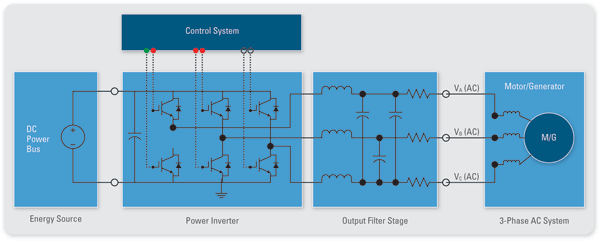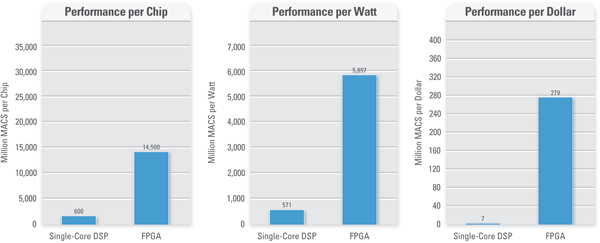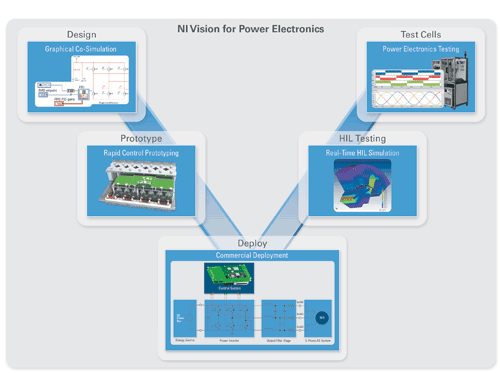Graphical system design changes how we manipulate, move, and store energy
BY BRIAN MACCLEERY
Principal Product Manager
National Instruments
www.ni.com
Hold on to your electric vehicle seat: Energy is going digital. When a technology goes digital, it changes everything. For starters, the rate of technology improvement takes a new slope — transitioning from glacially slow to exponentially fast. Think about online search and how it changed the way we find information, how social media changed the way we receive news, and how electronic books and e-readers changed the way we buy books. When a technology goes digital, words like “library,” “newspaper,” and “bookstore” start to sound like relics of the past.
What defines the transition from analog to digital and how can we tell when energy has made the jump? First, the digital control of energy, in the form of electricity, requires smart sensors that acquire voltage and current, fast digital signal processing to change raw measurements into meaningful information, and special switched-mode power supply (SMPS) circuits to electronically chop power into pulses that the system can manipulate.
Second, digital energy systems must be networked and field reconfigurable to send data that makes continuous improvements and bug fixes possible and download software updates from a server.
Third, the system must be modeled and simulated with high accuracy and speed, including the interaction between the analog circuitry and the digital embedded software code. Simulation is critical to test, optimize, and validate improvements in a safe environment so they can be deployed with confidence to the embedded systems in the field.
When an analog technology goes digital, it becomes an information technology — a software problem. The digital energy revolution is enabled by powerful software tools, ample computing power, secure Internet backbones, specialized embedded hardware systems, and one more thing — power electronics.
Controlling power with electronics
The technology enabler for the electronic control of power, better known as power electronics, is the power transistor that converts, controls, manipulates, and transfers large amounts of electric energy (see Fig. 1 ). These power switching devices, namely IGBTs and MOSFETs, chop megawatts of electric power for pennies per watt.
Energy efficiency doubles roughly every 11 years while prices decrease steadily. Today, an inexpensive inverter system can control 85% more power than a 1980s-era system and lose just a few percent of that power to waste heat. The ability to digitally manipulate megawatts of power with low losses is truly a game changer.
At the same time, the performance of embedded processors and field-programmable gate arrays (FPGAs) is increasing at staggering rates. Whereas analog control systems were significantly higher performance per dollar in the late 1990s, the advance of Moore’s law is helping digital control systems zoom past their analog predecessors. The recent incorporation of mini hardcore digital signal processing (DSP) elements into FPGA fabric makes FPGAs a clear winner for digital energy control systems.

Fig. 1: Typical elements of a digital electronic power control system include an energy source, power inverter, output filter stage, and three-phase ac system.
The performance per dollar of FPGAs doubles every 14 months, which is just longer than the 12 to 13 months it takes a team of 15 engineers to develop a custom embedded design. Keeping up with the exponentially accelerating pace of Moore’s Law is moving engineering managers to rely on commercial off-the-shelf (COTS) technology. This is the motivation for devices like the new NI Single-Board RIO general-purpose inverter control (GPIC) product — a cost-effective, off-the-shelf board with all the I/O for power electronics control and the latest FPGA and real-time processor technology.
Modern FPGAs provide an ideal architecture for power electronics control systems because they enable you to place custom high-frequency digital pulse-width modulators (DPWMs) and digital control circuitry in dedicated hardware (see Fig. 2 ). The inherent field reconfigurability of FPGAs is especially beneficial for smart-grid applications from the perspective of long-term support, maintenance, and interoperability with evolving standards and communication protocols.
System-level graphical programming languages and the emergence of COTS hardware targets optimized for high-volume commercial deployment provide an alternative to fully custom hardware development. Reconfigurable COTS systems such as the new NI GPIC platform eliminate significant cost and risk associated with custom board design for high-volume commercial deployment.

Fig. 2: The recent incorporation of mini hardcore DSPs into FPGA fabric has dramatically increased the performance of FPGAs compared to single-core DSPs as measured in multiply-accumulate operations per second (MACS).
Completing the ‘design V’ for power electronics
Digital energy technologies play a central role in increasing the performance and reducing the cost of solar, wind, and energy storage systems. National Instruments R&D is making investments to provide a comprehensive tool-chain for the digital energy revolution. The vision is to complete the “design V” for power electronics.
The design V, which you may know from the automotive and aerospace industries, describes an integrated process for product design and test. NI is investing at each step of the V (see Fig. 3 ) to improve in the design, prototyping, and deployment of commercial digital energy products. The goal is to eliminate issues that reduce the productivity of embedded design teams.
The graphical system design approach begins with co-simulation, which enables you to develop LabVIEW FPGA code within a high-fidelity simulation environment that captures the interaction between the digital control system and analog power electronics. LabVIEW FPGA and the NI Multisim power electronics circuit simulator automatically adjust the simulation timestep to capture the fast transient behavior of the analog circuitry and its interaction with the FPGA-based control system. For example, if the current in an inductor is ringing, the simulation automatically slows down to capture the effect on the digital control system.
What’s most important is to enable teams to develop their actual LabVIEW FPGA code within the simulation environment and then move it to a physical FPGA target with little effort. This enables a completely bidirectional development path. Changes made to the software at any stage from prototype to post-production automatically update anywhere that code is referenced in the tool chain. The goal is to write the embedded systems code on day one and continually improve it throughout development. You can design the power electronics circuitry in parallel with the FPGA software and the automated test code to help you evaluate the nonlinear design trade-offs between energy efficiency, cost, and component lifetime. This creates the opportunity to optimize for multiple design goals simultaneously, even given difficult trade-offs.
To eliminate the need to manually tweak and possibly contaminate generated code, the FPGA resource utilization efficiency must be comparable to handwritten register transfer-level (RTL) code. Also, the design platform must include fixed-point math blocks and power electronics IP libraries that enable efficient development of control, signal processing, and power analysis algorithms. Finally, the tool chain must target pre-validated COTS control boards that meet the specific control, I/O, performance, and cost needs of high-volume commercial digital energy products.
On the right side of the power electronics design V is the challenge of how to test complex, high-power digital energy systems. The biggest issue in the past was a lack of real-time simulators for validation and verification. This is another area in which FPGA technology provides a solution. The same graphical system design tools are suitable for developing fast, real-time hardware-in-the-loop (HIL) simulators for the comprehensive validation of grid-tied power electronics systems.

Fig. 3: NI is working to complete the digital energy “design V” by providing a comprehensive toolchain for the rapid design, commercialization, and validation testing of digital power electronics control systems.
Imagining the future
It may be hard to imagine a world in which energy becomes a software problem, just looking for the right algorithms to efficiently convert, control, transfer, and store it. That’s what the digital energy revolution makes possible. How will we know it has happened? You can call it a digital energy technology if the system is digitized and digitally controlled, networked, field reconfigurable, modeled, simulated, and improving exponentially in performance per dollar each year.
What grand challenges of engineering will the digital energy revolution help us address? One thing is clear — these technologies are rapidly increasing in performance and falling in price, and they lie at the heart of renewable energy, smart grid, and electric vehicle systems. ■
Advertisement
Learn more about National Instruments





